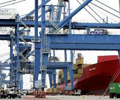India’s top LNG importer mulls increasing term offtake as spot demand vanishes

India’s appetite for spot LNG cargoes has evaporated as prices set new seasonal highs this September, prompting end-users to switch to alternative fuels, AK Singh, chief executive of Petronet LNG, told S&P Global Platts on Sept. 22 on the sidelines of the Gastech 2021 conference.
“Last year, almost 50% of our imports were sourced from spot purchases [but] this 50% spot volume has literally vanished at these high LNG prices,” Singh said, when asked about the dramatic surge in Asia’s spot LNG prices to over $28/MMBtu, a new record for September assessments.
The S&P Global Platts JKM price for November delivery was assessed at $27.266/MMBtu on Sept. 22, a touch lower from the previous day, supported by spot purchases by portfolio majors and trading houses as current prices have dampened interest in spot trades among most national oil companies and utilities.
Platts assessed the TTF November contract at $24.342/MMBtu on Sept. 22.
“It’s crazy, [the current prices] cannot be accepted by the consumers,” Singh said, adding that spot LNG is now “very difficult to sell in India.”
Open to talks on term offtake
Asked whether Petronet LNG is seeking term offtake after shelving a deal with US-based project developer Tellurian last year, Singh said: “We are open to any talks provided we get a better deal – Middle East is definitely of interest [but so are] all countries if we can get affordable cargoes.”
Back in November, Petronet’s senior executives had indicated during an analyst conference that it may shelve the Tellurian deal, which also called for an investment in the Driftwood LNG project in the US, because the market was then awash with cheap LNG.
The tables have turned with Singh lamenting over a huge jump in prices to “three to four times more than what it used to be last year.”
Speaking at a Gastech panel discussion also held on Sept. 22, the chief executive of India’s top LNG importer, which operates two terminals with 22.5 million mt/year capacity at Kochi and Dahej, shed light on the company’s baseline for LNG pricing.
“We don’t expect natural gas to be price competitive with coal [but] it should be at least competitive with liquid fuels,” Singh said, alluding to expectations that end-users particularly in India’s industrial sector are now incentivized to switch to oil products.
He argued that persistently high LNG prices are not justifiable because the availability of huge undeveloped gas reserves should keep upstream production costs low.
“Our expectation is that suppliers and producers will realize there is huge demand potential in our country — affordability and competitive of price will be key,” he said.
India to more than double gas use
The government of India has aimed to lift the share of natural gas in the country’s energy mix to 15% by 2030, up from 6%, as it strives to achieve a 33%-35% reduction in emission intensity of its gross domestic product pledged under the Paris climate change accord in 2015.
City gas distribution, fertilizer and petrochemical production drive the bulk of India’s natural gas demand. The country has not outlined any zero-emission target to date.
Singh estimated that LNG imports met almost 57% of India’s domestic natural gas requirements last year and this share would grow to 70% by 2030.
He viewed natural gas as complementing renewables in the transition to a low carbon economy, resonating the sentiments aired by the operator of Pakistan’s largest LNG import terminal at Gastech 2021.
Pakistan Gasport Chairman Iqbal Ahmed said that natural gas will stay relevant to Asia for another 20 years, twice longer than 10 years projected for developed countries in North America and Europe.
“We hope the current volatile market will normalize very soon so that developing countries can benefit from the use of gas,” Singh said.
Meanwhile, India has already imported its first carbon neutral LNG cargo in 2019 through a shipment brought in by Japan’s LNG buyer Jera from Abu Dhabi.
Singh said Petronet looked upon industry groups like GIIGNL for guidelines on assessing the carbon footprint of LNG cargoes while continuing to engage the international community to develop the methodology to assess the emission footprint of LNG cargoes.
He added that the LNG terminal operator is looking to set up a third import facility of 5 million mt/year along the east coast.
Source: Platts

 Hellenic Shipping News Worldwide Hellenic Shipping News Worldwide, Online Daily Newspaper on Hellenic and International Shipping
Hellenic Shipping News Worldwide Hellenic Shipping News Worldwide, Online Daily Newspaper on Hellenic and International Shipping





















 PG-Software
PG-Software